Dell PP07S, 700m User Manual
Dell™ Inspiron™ 700m
Owner’s Manual
Model PP07S
w w w . d e l l . c o m | s u p p o r t . d e l l . c o m

Notes, Notices, and Cautions
NOTE: A NOTE indicates important information that helps you make better use of your computer.
NOTICE: A NOTICE indicates either potential damage to hardware or loss of data and tells you how to avoid the problem.
 CAUTION: A CAUTION indicates a potential for property damage, personal injury, or death.
CAUTION: A CAUTION indicates a potential for property damage, personal injury, or death.
Abbreviations and Acronyms
For a complete list of abbreviations and acronyms, see the Dell Inspiron Help file. To access the help file, see "Finding Information" on page 9.
If you purchased a Dell™ n Series computer, any references in this document to Microsoft® Windows® operating systems are not applicable.
Information in this document is subject to change without notice. © 2004–2005 Dell Inc. All rights reserved.
Reproduction in any manner whatsoever without the written permission of Dell Inc. is strictly forbidden.
Trademarks used in this text: Dell, the DELL logo, Inspiron, Dell Precision, Dell TravelLite, Dimension, OptiPlex, Latitude, TrueMobile, DellNet, PowerApp, PowerEdge, PowerConnect, PowerVault, and Axim are trademarks of Dell Inc.; Intel, Pentium, and Celeron are registered trademarks of Intel Corporation; Microsoft, Windows, and Outlook are registered trademarks of Microsoft Corporation; EMC is a registered trademark of EMC Corporation; Bluetooth is a trademark owned by Bluetooth SIG, Inc. and is used by Dell Inc. under license.
Other trademarks and trade names may be used in this document to refer to either the entities claiming the marks and names or their products. Dell Inc. disclaims any proprietary interest in trademarks and trade names other than its own.
Model PP07S
April 2005 |
P/N G7472 |
Rev. A02 |
w w w . d e l l . c o m | s u p p o r t . d e l l . c o m

Installing a Battery . . . . . . . . . . . . . . . . . . . . . . . . . . . . |
27 |
Storing a Battery. . . . . . . . . . . . . . . . . . . . . . . . . . . . . . |
27 |
4 Installing Module Bay Devices
About the Module Bay . . . . . . . . . . . . . . . . . . . . . . . . . . . |
29 |
Removing and Installing Devices While the Computer Is Turned Off . . . . . |
29 |
Removing and Installing Devices While the Computer Is Running . . . . . . |
30 |
5 Using CDs, DVDs, and Other Multimedia
Using CDs and DVDs . . . . . . . . . . . . . . . . . . . . . . . . . . . . |
31 |
Copying CDs and DVDs. . . . . . . . . . . . . . . . . . . . . . . . . . . |
31 |
How to Copy a CD or DVD . . . . . . . . . . . . . . . . . . . . . . . |
31 |
Using Blank CD-Rs and CD-RWs . . . . . . . . . . . . . . . . . . . . |
32 |
Helpful Tips . . . . . . . . . . . . . . . . . . . . . . . . . . . . . . |
32 |
Connecting Your Computer to a TV or Audio Device . . . . . . . . . . . . . |
33 |
S-Video Connection . . . . . . . . . . . . . . . . . . . . . . . . . . |
33 |
Enabling the Display Settings for a TV . . . . . . . . . . . . . . . . . |
34 |
6 Using the Keyboard and Touch Pad
Numeric Keypad . . . . . . . . . . . . . . . . . . . . . . . . . . . . . . |
35 |
Key Combinations . . . . . . . . . . . . . . . . . . . . . . . . . . . . . |
36 |
System Functions . . . . . . . . . . . . . . . . . . . . . . . . . . . |
36 |
Display Functions . . . . . . . . . . . . . . . . . . . . . . . . . . . |
36 |
Radios (Including Wireless Networking) . . . . . . . . . . . . . . . . |
36 |
Power Management. . . . . . . . . . . . . . . . . . . . . . . . . . |
36 |
Speaker Functions . . . . . . . . . . . . . . . . . . . . . . . . . . |
36 |
Microsoft® Windows® Logo Key Functions . . . . . . . . . . . . . . |
37 |
Touch Pad . . . . . . . . . . . . . . . . . . . . . . . . . . . . . . . . . |
37 |
Customizing the Touch Pad . . . . . . . . . . . . . . . . . . . . . . |
38 |
4 Contents

7 Using PC Cards |
|
PC Card Types . . . . . . . . . . . . . . . . . . . . . . . . . . . . . . . |
39 |
PC Card Blanks . . . . . . . . . . . . . . . . . . . . . . . . . . . . . . |
39 |
Extended PC Cards. . . . . . . . . . . . . . . . . . . . . . . . . . . . . |
39 |
Removing a PC Card or Blank . . . . . . . . . . . . . . . . . . . . . . . |
39 |
Installing a PC Card . . . . . . . . . . . . . . . . . . . . . . . . . . . . |
41 |
8 Setting Up a Home and Office Network |
|
Connecting to a Network Adapter . . . . . . . . . . . . . . . . . . . . . |
43 |
Network Setup Wizard . . . . . . . . . . . . . . . . . . . . . . . . . . . |
44 |
Connecting to a Wireless Local Area Network . . . . . . . . . . . . . . . |
44 |
Determining Your Network Type . . . . . . . . . . . . . . . . . . . . |
44 |
Connecting to a Wireless Network in Microsoft® Windows® XP. . . . . |
45 |
9 Solving Problems
Dell Diagnostics . . . . . . . . . . . . . . . . . . . . . . . . . . . . . . |
47 |
When to Use the Dell Diagnostics . . . . . . . . . . . . . . . . . . . |
47 |
Starting the Dell Diagnostics. . . . . . . . . . . . . . . . . . . . . . |
47 |
Drivers . . . . . . . . . . . . . . . . . . . . . . . . . . . . . . . . . . |
49 |
What Is a Driver? . . . . . . . . . . . . . . . . . . . . . . . . . . . |
49 |
Identifying Drivers. . . . . . . . . . . . . . . . . . . . . . . . . . . |
49 |
Reinstalling Drivers and Utilities . . . . . . . . . . . . . . . . . . . . |
50 |
Resolving Software and Hardware Incompatibilities . . . . . . . . . . . . |
51 |
Restoring Your Operating System . . . . . . . . . . . . . . . . . . . . . . |
51 |
Using Microsoft Windows XP System Restore . . . . . . . . . . . . . |
51 |
Using Dell PC Restore by Symantec . . . . . . . . . . . . . . . . . . |
52 |
Drive Problems . . . . . . . . . . . . . . . . . . . . . . . . . . . . . . |
54 |
CD and DVD drive problems . . . . . . . . . . . . . . . . . . . . . . |
55 |
If you cannot eject the CD, CD-RW, DVD, or DVD+RW drive tray . . . . . 55 |
|
If you hear an unfamiliar scraping or grinding sound . . . . . . . . . . |
56 |
Hard drive problems. . . . . . . . . . . . . . . . . . . . . . . . . . |
56 |
Contents 5

E-Mail, Modem, and Internet Problems . . . . . . . . . . . . . . . . . . . |
56 |
Error Messages . . . . . . . . . . . . . . . . . . . . . . . . . . . . . . |
58 |
IEEE 1394 Device Problems. . . . . . . . . . . . . . . . . . . . . . . . . |
59 |
Keyboard Problems . . . . . . . . . . . . . . . . . . . . . . . . . . . . |
59 |
External Keyboard Problems . . . . . . . . . . . . . . . . . . . . . . |
60 |
Unexpected Characters . . . . . . . . . . . . . . . . . . . . . . . . |
60 |
Lockups and Software Problems . . . . . . . . . . . . . . . . . . . . . . |
60 |
The computer does not start up . . . . . . . . . . . . . . . . . . . . |
61 |
The computer stops responding . . . . . . . . . . . . . . . . . . . . |
61 |
A program stops responding . . . . . . . . . . . . . . . . . . . . . . |
61 |
A program crashes repeatedly . . . . . . . . . . . . . . . . . . . . . |
61 |
A program is designed for an earlier Windows operating system. . . . . |
61 |
A solid blue screen appears . . . . . . . . . . . . . . . . . . . . . . |
62 |
Other software problems . . . . . . . . . . . . . . . . . . . . . . . |
62 |
Memory Problems . . . . . . . . . . . . . . . . . . . . . . . . . . . . . |
63 |
Network Problems. . . . . . . . . . . . . . . . . . . . . . . . . . . . . |
63 |
PC Card Problems . . . . . . . . . . . . . . . . . . . . . . . . . . . . . |
64 |
Power Problems . . . . . . . . . . . . . . . . . . . . . . . . . . . . . . |
64 |
Ensuring Sufficient Power for Your Computer . . . . . . . . . . . . . . |
65 |
Printer Problems. . . . . . . . . . . . . . . . . . . . . . . . . . . . . . |
65 |
Scanner Problems . . . . . . . . . . . . . . . . . . . . . . . . . . . . . |
66 |
Sound and Speaker Problems . . . . . . . . . . . . . . . . . . . . . . . |
67 |
No sound from integrated speakers . . . . . . . . . . . . . . . . . . |
67 |
No sound from external speakers . . . . . . . . . . . . . . . . . . . |
67 |
No sound from headphones . . . . . . . . . . . . . . . . . . . . . . |
68 |
Touch Pad or Mouse Problems . . . . . . . . . . . . . . . . . . . . . . . |
68 |
Video and Display Problems . . . . . . . . . . . . . . . . . . . . . . . . |
69 |
If the display is blank . . . . . . . . . . . . . . . . . . . . . . . . . |
69 |
If the display is difficult to read. . . . . . . . . . . . . . . . . . . . . |
69 |
If only part of the display is readable . . . . . . . . . . . . . . . . . . |
70 |
6 Contents

10 Adding and Replacing Parts
Before You Begin . . . . . . . . . . . . . . . . . . . . . . . . . . . . . |
71 |
Recommended Tools . . . . . . . . . . . . . . . . . . . . . . . . . |
71 |
Turning Off Your Computer . . . . . . . . . . . . . . . . . . . . . . . |
71 |
Before Working Inside Your Computer . . . . . . . . . . . . . . . . . |
72 |
Memory . . . . . . . . . . . . . . . . . . . . . . . . . . . . . . . . . . |
73 |
Modem . . . . . . . . . . . . . . . . . . . . . . . . . . . . . . . . . . |
75 |
Mini PCI Card . . . . . . . . . . . . . . . . . . . . . . . . . . . . . . . |
76 |
11 Appendix
Specifications . . . . . . . . . . . . . . . . . . . . . . . . . . . . . . . |
81 |
Using the System Setup Program . . . . . . . . . . . . . . . . . . . . . . |
86 |
Overview . . . . . . . . . . . . . . . . . . . . . . . . . . . . . . . |
86 |
Viewing the System Setup Screens. . . . . . . . . . . . . . . . . . . |
87 |
System Setup Screens. . . . . . . . . . . . . . . . . . . . . . . . . |
87 |
Commonly Used Options. . . . . . . . . . . . . . . . . . . . . . . . |
87 |
Dell Technical Support Policy (U.S. Only) . . . . . . . . . . . . . . . . . . |
88 |
Definition of "Dell-Installed" Software and Peripherals . . . . . . . . . |
89 |
Definition of "Third-Party" Software and Peripherals . . . . . . . . . . |
89 |
Contacting Dell . . . . . . . . . . . . . . . . . . . . . . . . . . . . . . |
89 |
Macrovision Product Notice . . . . . . . . . . . . . . . . . . . . . . . |
107 |
FCC Notices (U.S. Only) . . . . . . . . . . . . . . . . . . . . . . . . . |
107 |
Class A . . . . . . . . . . . . . . . . . . . . . . . . . . . . . . . |
107 |
Class B . . . . . . . . . . . . . . . . . . . . . . . . . . . . . . . |
107 |
FCC Identification Information . . . . . . . . . . . . . . . . . . . . |
108 |
Index . . . . . . . . . . . . . . . . . . . . . . . . . . . . . . . . . . . |
109 |
Contents 7

8 Contents
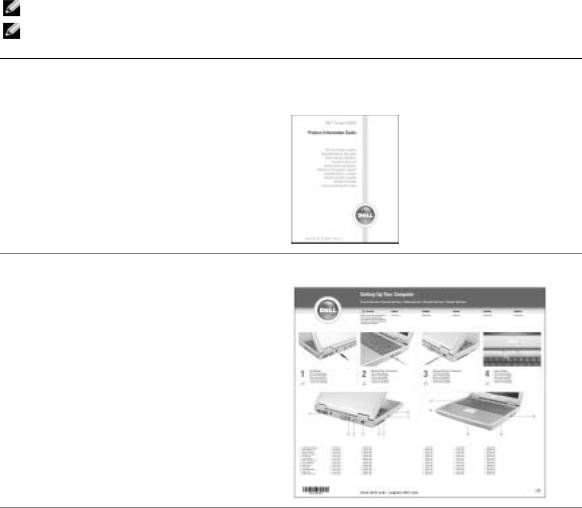
Finding Information
NOTE: Some features may not be available for your computer or in certain countries.
NOTE: Additional information may ship with your computer.
What Are You Looking For? |
Find It Here |
|
|
• Warranty information |
Dell™ Product Information Guide |
•Terms and Conditions (U.S. only)
•Safety instructions
•Regulatory information
•Ergonomics information
•End User License Agreement
• How to set up my computer |
Setup Diagram |
• Tips on using Microsoft® Windows® |
Help File |
|
• How to play CDs and DVDs |
1 |
Click the Start button and click Help and Support. |
• How to use standby mode and hibernate mode |
2 |
Click User and system guides and click User’s guides. |
• How to change my display resolution |
3 |
Click Dell Inspiron Help. |
• How to clean my computer |
|
|
Finding Information |
|
9 |
|

w w w . d e l l . c o m | s u p p o r t . d e l l . c o m
What Are You Looking For?
•Service Tag and Express Service Code
•Microsoft Windows License Label
Find It Here
Service Tag and Microsoft Windows License
These labels are located on the bottom of your computer.
• Use the Service Tag to identify your computer when you use support.dell.com or contact technical support.
•Enter the Express Service Code to direct your call when contacting technical support.
10 Finding Information

What Are You Looking For? |
Find It Here |
|
|
• Solutions — Troubleshooting hints and tips, articles |
Dell Support Website — support.dell.com |
from technicians, online courses, frequently asked |
NOTE: Select your region to view the appropriate support |
questions |
site. |
• Community — Online discussion with other Dell |
NOTE: Corporate, government, and education customers |
customers |
can also use the customized Dell Premier Support website |
• Upgrades — Upgrade information for components, such |
at premier.support.dell.com. The website may not be |
as memory, the hard drive, and the operating system |
available in all regions. |
• Customer Care — Contact information, service call and |
|
order status, warranty, and repair information |
|
• Service and support — Service call status and support |
|
history, service contract, online discussions with |
|
technical support |
|
• Reference — Computer documentation, details on my |
|
computer configuration, product specifications, and |
|
white papers |
|
• Downloads — Certified drivers, patches, and software |
|
updates |
|
• Notebook System Software (NSS)— If you reinstall the |
|
operating system for your computer, you should also |
|
reinstall the NSS utility. NSS provides critical updates |
|
for your operating system and support for Dell™ |
|
3.5-inch USB floppy drives, Intel® Pentium® M |
|
processors, optical drives, and USB devices. NSS is |
|
necessary for correct operation of your Dell computer. |
|
The software automatically detects your computer and |
|
operating system and installs the updates appropriate |
|
for your configuration. |
|
To download Notebook System Software: |
|
1 Go to support.dell.com and click Downloads. |
|
2 Enter your Service Tag or product model. |
|
3 In the Download Category drop-down menu, click All. |
|
4 Select the operating system and operating system |
|
language for your computer, and click Submit. |
|
5 Under Select a Device, scroll to System and |
|
Configuration Utilities, and click Dell Notebook |
|
System Software. |
|
Finding Information |
|
11 |
|

w w w . d e l l . c o m | s u p p o r t . d e l l . c o m
What Are You Looking For? |
Find It Here |
|
|
|
|
• How to use Windows XP |
Windows Help and Support Center |
|
• Documentation for my computer |
1 |
Click the Start button and click Help and Support. |
• Documentation for devices (such as a modem) |
2 |
Type a word or phrase that describes your problem and |
|
|
click the arrow icon. |
|
3 |
Click the topic that describes your problem. |
|
4 |
Follow the instructions on the screen. |
|
|
|
12 Finding Information

A Tour of Your Computer
Front View
 display latch release
display latch release
 display
display
device and keyboard |
speakers (2) |
status lights |
|
keyboard |
power button |
|
touch pad 
touch pad buttons
IEEE 1394 connector |
microphone connector |
|
headphone connector |
DISPLAY LATCH RELEASE — Slide this display latch to release and open the display.
DISPLAY — For more information about your display, see "Using the Display" in the Dell Inspiron Help file. To access help, see "Finding Information" on page 9.
SPEAKERS — To adjust the volume of the integrated speakers press the volume control keyboard shortcuts. For more information, see "Using the Keyboard and Touch Pad" on page 35.
POWER BUTTON — Press the power button to turn on the computer or to enter or exit a power management mode.
NOTICE: To avoid losing data, shut down your computer instead of pressing the power button.
A Tour of Your Computer |
|
13 |
|
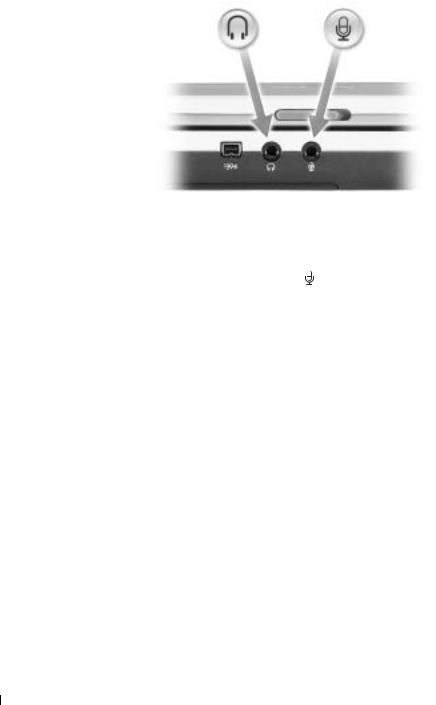
w w w . d e l l . c o m | s u p p o r t . d e l l . c o m
AUDIO CONNECTORS — Connect headphones and microphone.
Attach headphones or speakers to the  connector.
connector.
Attach a microphone to the |
connector. |
IEEE 1394 CONNECTOR — Connects devices supporting IEEE 1394 high-speed transfer rates, such as some digital video cameras.
TOUCH PAD — Touch pad and touch pad buttons provide the functionality of a mouse. See "Using the Keyboard and Touch Pad" on page 35 for more information.
KEYBOARD — The keyboard includes a numeric keypad as well as the Microsoft® Windows® logo key. For information on supported keyboard shortcuts, see "Using the Keyboard and Touch Pad" on page 35.
14 A Tour of Your Computer
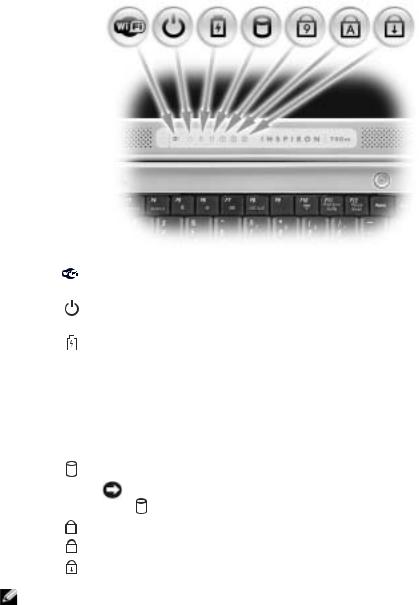
DEVICE AND KEYBOARD STATUS LIGHTS
Turns on when wireless networking is enabled. To enable or disable wireless networking, press <Fn><F2>.
Turns on when you turn on the computer. Turns on steadily or blinks when the computer is in a power management mode.
9
A
Indicates battery charge status.
If the computer is connected to an electrical outlet, the  light operates as follows:
light operates as follows:
– Solid green: The battery is charging.
If the computer is running on a battery, the  light operates as follows:
light operates as follows:
–Off: The battery is adequately charged (or the computer is turned off).
–Flashing green: The battery charge is low.
Turns on when the computer reads or writes data.
NOTICE: To avoid loss of data, never turn off the computer while the light is flashing.
Turns on when the numeric keypad is enabled.
Turns on when the uppercase letter function is enabled.
Turns on when the scroll lock function is enabled.
NOTE: Device status lights are also visible when the display is closed.
A Tour of Your Computer |
|
15 |
|

w w w . d e l l . c o m | s u p p o r t . d e l l . c o m
Left Side View
security cable slot
|
video connector |
PC Card slot |
exhaust vent |
USB connectors (2) |
Secure Digital |
|
|
memory card slot |
SECURITY CABLE SLOT — Lets you attach a commercially available antitheft device to the computer. For more information, see the instructions included with the device.
NOTICE: Before you buy an antitheft device, ensure that it will work with the security cable slot.
EXHAUST VENT — The computer uses an internal fan to create airflow through the vents, which prevents the computer from overheating.
NOTE: The computer turns on the fan when the computer gets hot. Fan noise is normal and does not indicate a problem with the fans or the computer.
CAUTION: Do not block, push objects into, or allow dust to accumulate in the air vents. Do not store your computer in a low-airflow environment, such as a closed briefcase, while it is running. Restricting the airflow can damage the computer or cause a fire.
16 A Tour of Your Computer

VIDEO CONNECTOR
Connects an external monitor. For more information, see "Using the Display" in the Dell Inspiron Help file. To access help, see "Finding Information" on page 9.
USB 2.0 CONNECTOR
Connects USB 2.0 compliant devices, such as a mouse, keyboard, or printer.
PC CARD SLOT — Supports one PC Card, such as a modem or network adapter. The computer ships with a plastic blank installed in the slot. For more information, see "Using PC Cards" on page 39.
SECURE DIGITAL MEMORY CARD SLOT
The Secure Digital memory card slot supports one Secure Digital memory card. Use Secure Digital memory cards to save or back up data.
A Tour of Your Computer |
|
17 |
|
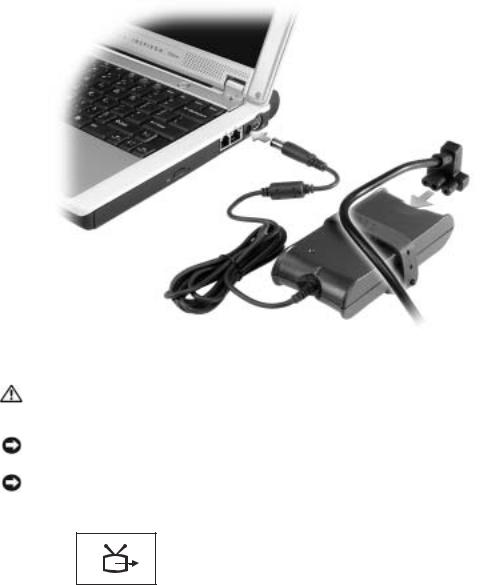
The AC adapter converts AC power to the DC power required by the computer. You can connect the AC adapter with your computer turned either on or off.
CAUTION: The AC adapter works with electrical outlets worldwide. However, power connectors and power strips vary among countries. Using an incompatible cable or improperly connecting the cable to the power strip or electrical outlet may cause fire or equipment damage.
NOTICE: When you disconnect the AC adapter cable from the computer, grasp the connector, not the cable itself, and pull firmly but gently to avoid damaging the cable.
NOTICE: Ensure that the AC adapter cable is not in the path of chairs or other objects that could crush it.
S-VIDEO TV-OUT CONNECTOR
Connects your computer to a TV. For more information, see "Connecting Your Computer to a TV or Audio Device" on page 33.
A Tour of Your Computer |
|
19 |
|
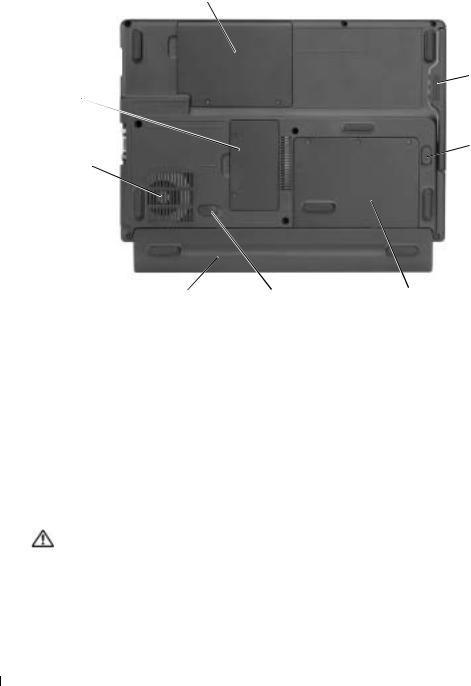
w w w . d e l l . c o m | s u p p o r t . d e l l . c o m
Bottom View
Mini PCI card and modem cover
memory |
module bay |
|
module |
||
|
||
cover |
|
|
|
module bay |
|
air vent |
latch release |
|
|
battery* |
battery latch release |
hard drive cover |
*optional 8-cell battery is shown
MODULE BAY — You can install devices such as an optical drive in the module bay. For more information, see "Installing Module Bay Devices" on page 29.
MODULE BAY LATCH RELEASE — Releases a device. See "Installing Module Bay Devices" on page 29 for instructions.
HARD DRIVE — Stores software and data.
BATTERY LATCH RELEASE — Releases a device. See "Using a Battery" on page 25 for instructions.
BATTERY/BATTERY BAY — When a battery is installed, you can use the computer without connecting the computer to an electrical outlet. See "Using a Battery" on page 25.
AIR VENT — The computer uses an internal fan to create airflow through the vents, which prevents the computer from overheating.
CAUTION: Do not block, push objects into, or allow dust to accumulate in the air vents. Do not store your computer in a low-airflow environment, such as a closed briefcase, while it is running. Restricting the airflow can damage the computer or cause a fire.
MEMORY MODULE COVER — Covers the compartment that contains the memory module. See "Memory" on page 73.
MINI PCI CARD AND MODEM COVER — Covers the compartment that contains the Mini PCI card and modem. See "Mini PCI Card" on page 76 and "Modem" on page 75.
20 A Tour of Your Computer

Setting Up Your Computer
Connecting to the Internet
NOTE: ISPs and ISP offerings vary by country.
To connect to the Internet, you need a modem or network connection and an Internet service provider (ISP), such as AOL or MSN. Your ISP will offer one or more of the following Internet connection options:
•Dial-up connections that provide Internet access through a telephone line. Dial-up connections are considerably slower than DSL and cable modem connections.
•DSL connections that provide high-speed Internet access through your existing telephone line. With a DSL connection, you can access the Internet and use your telephone on the same line simultaneously.
•Cable modem connections that provide high-speed Internet access through your local cable TV line.
If you are using a dial-up connection, connect a telephone line to the modem connector on your computer and to the telephone wall jack before you set up your Internet connection. If you are using a DSL or cable modem connection, contact your ISP for setup instructions.
Setting Up Your Internet Connection
To set up an AOL or MSN connection:
1Save and close any open files, and exit any open programs.
2Double-click the MSN Explorer or AOL icon on the Microsoft® Windows® desktop.
3Follow the instructions on the screen to complete the setup.
If you do not have an MSN Explorer or AOL icon on your desktop or if you want to set up an Internet connection with a different ISP:
1Save and close any open files, and exit any open programs.
2Click the Start button and click Internet Explorer. The New Connection Wizard appears.
3Click Connect to the Internet.
Setting Up Your Computer |
|
21 |
|

w w w . d e l l . c o m | s u p p o r t . d e l l . c o m
4In the next window, click the appropriate option:
•If you do not have an ISP and want to select one, click Choose from a list of Internet service providers (ISPs).
•If you have already obtained setup information from your ISP but you did not receive a setup CD, click Set up my connection manually.
•If you have a CD, click Use the CD I got from an ISP.
5Click Next.
If you selected Set up my connection manually, continue to step 6. Otherwise, follow the instructions on the screen to complete the setup.
NOTE: If you do not know which type of connection to select, contact your ISP.
6Click the appropriate option under How do you want to connect to the Internet?, and then click Next.
7Use the setup information provided by your ISP to complete the setup.
If you are having problems connecting to the Internet, see "E-Mail, Modem, and Internet Problems" on page 56. If you cannot connect to the Internet but have successfully connected in the past, the ISP might have a service outage. Contact your ISP to check the service status, or try connecting again later.
Setting Up a Printer
NOTICE: Complete the operating system setup before you connect a printer to the computer.
See the documentation that came with the printer for setup information, including how to:
•Obtain and install updated drivers.
•Connect the printer to the computer.
•Load paper and install the toner or ink cartridge.
•Contact the printer manufacturer for technical assistance.
Printer Cable
Your printer may not come with a printer cable, so if you purchase a cable separately, ensure that it is compatible with your printer. If you purchased a printer cable at the same time you purchased your computer, the cable may arrive in the computer box.
Connecting a USB Printer
NOTE: You can connect USB devices while the computer is turned on.
1Complete the operating system setup if you have not already done so.
2Install the printer driver if necessary. See the documentation that came with your printer.
22 Setting Up Your Computer
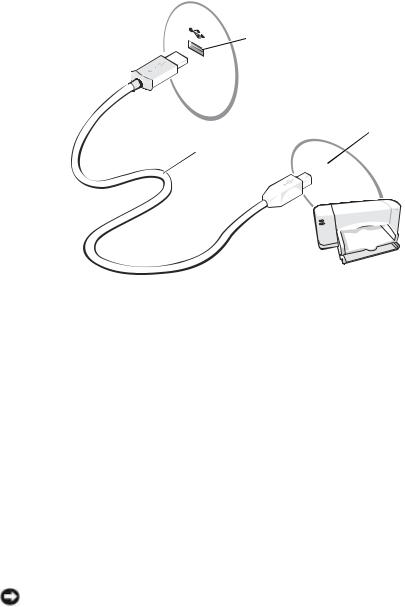
3Attach the USB printer cable to the USB connectors on the computer and the printer. The USB connectors fit only one way.
 USB connector on computer
USB connector on computer
 USB connector USB printer on printer cable
USB connector USB printer on printer cable 
Power Protection Devices
Several devices are available to protect against power fluctuations and failures:
•Surge protectors
•Line conditioners
•Uninterruptible power supplies (UPS)
Surge Protectors
Surge protectors and power strips equipped with surge protection help to prevent damage to your computer from voltage spikes that can occur during electrical storms or following power interruptions. The level of protection is usually commensurate with the cost of the surge protector. Some surge protector manufacturers include warranty coverage for certain types of damage. Carefully read the device warranty when choosing a surge protector. A device with a higher joule rating offers more protection. Compare joule ratings to determine the relative effectiveness of different devices.
NOTICE: Most surge protectors do not protect against power fluctuations or power interruptions caused by nearby lightning strikes. When lightning occurs in your area, disconnect the telephone line from the telephone wall jack and disconnect your computer from the electrical outlet.
Setting Up Your Computer |
|
23 |
|

w w w . d e l l . c o m | s u p p o r t . d e l l . c o m
Many surge protectors have a telephone jack for modem protection. See the surge protector documentation for modem connection instructions.
NOTICE: Not all surge protectors offer network adapter protection. Disconnect the network cable from the network wall jack during electrical storms.
Line Conditioners
NOTICE: Line conditioners do not protect against power interruptions.
Line conditioners are designed to maintain AC voltage at a fairly constant level.
Uninterruptible Power Supplies
NOTICE: Loss of power while data is being saved to the hard drive may result in data loss or file damage.
NOTE: To ensure maximum battery operating time, connect only your computer to a UPS. Connect other devices, such as a printer, to a separate power strip that provides surge protection.
A UPS protects against power fluctuations and interruptions. UPS devices contain a battery that provides temporary power to connected devices when AC power is interrupted. The battery charges while AC power is available. See the UPS manufacturer documentation for information on battery operating time and to ensure that the device is approved by Underwriters Laboratories (UL).
24 Setting Up Your Computer

Using a Battery
Battery Performance
CAUTION: Before you begin any of the procedures in this section, follow the safety instructions located in the Product Information Guide.
For optimal computer performance and to help preserve BIOS settings, operate your Dell™ portable computer with the main battery installed at all times. Use a battery to run the computer when it is not connected to an electrical outlet. One battery is supplied as standard equipment in the battery bay.
NOTE: Battery capacity (the time it can hold a charge) decreases over time. Depending on how often the battery is used and the conditions under which it is used, you may need to purchase a new battery during the life of your computer.
Battery operating time varies depending on operating conditions. Operating time is significantly reduced when you perform operations including, but not limited to, the following:
•Using DVD, DVD-R, and CD-RW drives
•Using wireless communications devices, PC Cards, or USB devices
•Using high-brightness display settings, 3D screen savers, or other power-intensive programs such as 3D games
•Running the computer in maximum performance mode (see "Power Management" in the
Dell Inspiron Help file.)
NOTE: It is recommended that you connect your computer to an electrical outlet when writing to a CD or DVD.
You can set power management options to alert you when the battery charge is low.
CAUTION: Using an incompatible battery may increase the risk of fire or explosion. Replace the battery only with a compatible battery purchased from Dell. The lithium-ion battery is designed to work with your Dell computer. Do not use a battery from other computers with your computer.
CAUTION: Do not dispose of batteries with household waste. When your battery no longer holds a charge, call your local waste disposal or environmental agency for advice on disposing of a lithium-ion battery. See "Battery Disposal" in the Product Information Guide.
CAUTION: Misuse of the battery may increase the risk of fire or chemical burn. Do not puncture, incinerate, disassemble, or expose the battery to temperatures above 65°C (149°F). Keep the battery away from children. Handle damaged or leaking batteries with extreme care. Damaged batteries may leak and cause personal injury or equipment damage.
Using a Battery |
|
25 |
|

w w w . d e l l . c o m | s u p p o r t . d e l l . c o m
Checking the Battery Charge
The Microsoft® Windows® Power Meter window and icon and the low-battery warning provide information on the battery charge.
Microsoft Windows Power Meter
The Windows Power Meter indicates the remaining battery charge. To check the Power Meter, double-click the icon on the taskbar. For more information about the Power Meter tab,
see "Power Management" in the Dell Inspiron Help file. To access help, see "Finding Information" on page 9.
If the computer is connected to an electrical outlet, a  icon appears.
icon appears.
Low-Battery Warning
NOTICE: To avoid losing or corrupting data, save your work immediately after a low-battery warning. Then connect the computer to an electrical outlet. If the battery runs completely out of power, hibernate mode begins automatically.
A pop-up window warns you when the battery charge is approximately 90 percent depleted. For more information about low-battery alarms, see "Power Management" in the Dell Inspiron Help file. To access help, see "Finding Information" on page 9.
Charging the Battery
When you connect the computer to an electrical outlet or install a battery while the computer is connected to an electrical outlet, the computer checks the battery charge and temperature.
If necessary, the AC adapter then charges the battery and maintains the battery charge.
If the battery is hot from being used in your computer or being in a hot environment, the battery may not charge when you connect the computer to an electrical outlet.
For more information about resolving problems with a battery, see "Power Problems" on page 64.
26 Using a Battery
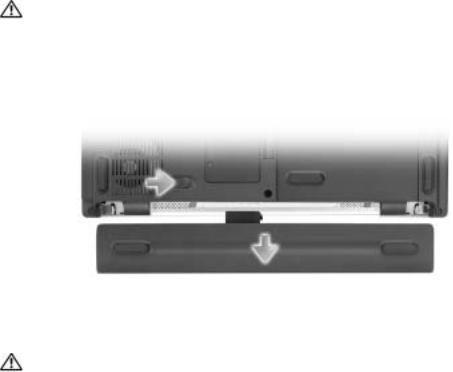
Removing a Battery
CAUTION: Before performing these procedures, disconnect the modem from the telephone wall jack.
1Ensure that the computer is turned off, set to the hibernate power management mode, or connected to an electrical outlet.
2Slide and hold the battery-bay latch release on the bottom of the computer, and then remove the battery from the bay.
shown with optional 8-cell battery
Installing a Battery
CAUTION: Using an incompatible battery may increase the risk of fire or explosion. Replace the battery only with a compatible battery purchased from Dell. The lithium-ion battery is designed to work with your Dell computer. Do not use a battery from other computers with your computer.
Slide the battery into the bay until the latch release clicks.
Storing a Battery
Remove the battery when you store your computer for an extended period of time. A battery discharges during prolonged storage. After a long storage period, recharge the battery fully before you use it.
Using a Battery |
|
27 |
|

w w w . d e l l . c o m | s u p p o r t . d e l l . c o m
Battery a Using 28

Installing Module Bay Devices
About the Module Bay
CAUTION: Before you begin any of the procedures in this section, follow the safety instructions located in the Product Information Guide.
You can install devices such as a DVD drive, CD-RW/DVD drive, or DVD+RW in the module bay.
Removing and Installing Devices While the Computer Is
Turned Off
NOTICE: To prevent damage to devices, store them in a safe, dry place when they are not installed in the computer. Avoid pressing down on them or placing heavy objects on top of them.
1 Slide and hold the device latch release.
2Pull the device out of the module bay.
3Push the new device into the bay until it clicks.
Installing Module Bay Devices |
|
29 |
|
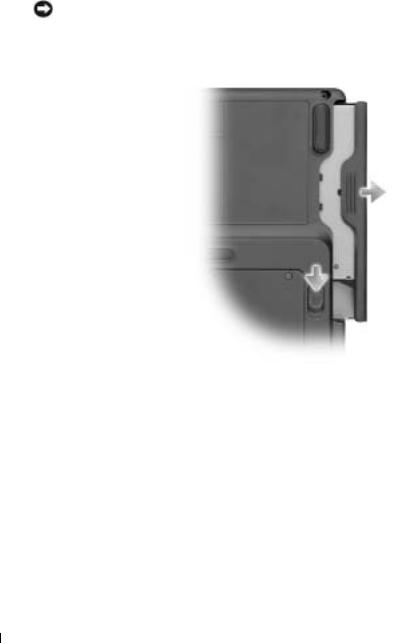
w w w . d e l l . c o m | s u p p o r t . d e l l . c o m
Removing and Installing Devices While the Computer
Is Running
1Before ejecting the device, double-click the Safely Remove Hardware icon on the taskbar, click the device you want to eject, and click Stop.
NOTICE: To prevent damage to devices, store them in a safe, dry place when they are not installed in the computer. Avoid pressing down on them or placing heavy objects on top of them.
2 Slide and hold the device latch release.
3Pull the device out of the module bay.
4Push the new device into the bay until it clicks.
The operating system automatically recognizes the device.
30 Installing Module Bay Devices
